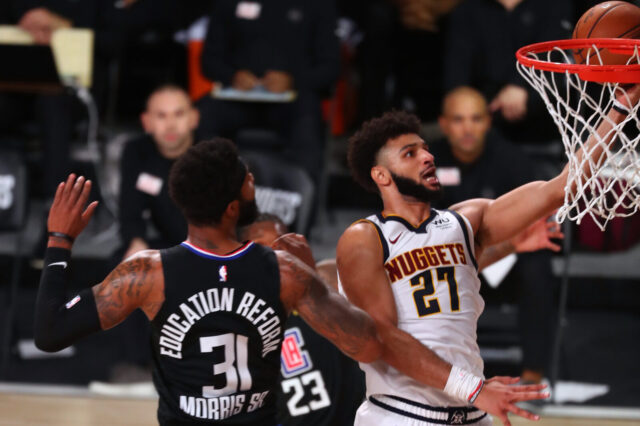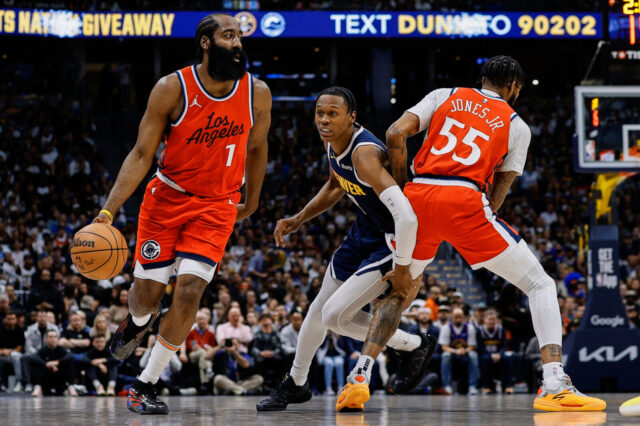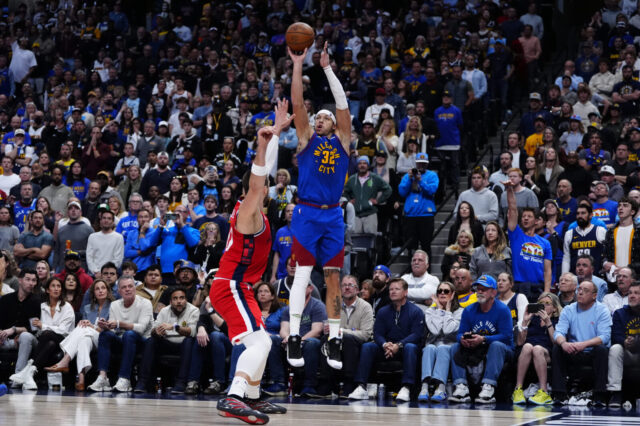The Nuggets showed patience in transition
One of the main talking points I’ve discussed on the Locked on Nuggets podcast is how the Nuggets can afford to be especially patient in transition thanks to their hyper-efficient half court offense. This is especially true when the starting lineup is on the court.
In the clip below, Will Barton gets a decent opportunity to attack in transition but decides to pull the ball out and allow the team to hunt for a better shot. This is a more difficult decision that you might think. The Seven Seconds or Less Phoenix Suns revolutionized the game in part because they identified that field goal attempts early in the shot clock tend to be more efficient than shots in the half court. It’’s easier to score, easier to draw a foul, and easier to grab an offensive rebound when the defense hasn’t had a chance to get set. But there is a tipping point where a shot attempt is no longer more valuable simply because the defense isn’t set and for the Nuggets, that point is a bit further to the side of being patient than most teams.
Barton’s decision led to a great possession where the ball touched all five players, the defense was forced to navigate five different ball screens, and ultimately ends with an open bucket. This was the second halfcourt possession of the game and it set the tone for what turned out to be a very efficient night for the Nuggets’ offense.
The difference between cutting backdoor and slipping the screen
There was a play in the second quarter of the game that provided an example of the difference between a backdoor cut and a slip screen. When teams switch off ball screens, especially pindown screens, there is usually a great opportunity for the screener to slip toward the basket before the switch occurs. Paul Millsap did a nice job of that in the clip below and it led to a wide open dunk.
Mason Plumlee slips the screen
Here is another example of how a slip screen can freeze the defensive switch.
Malik Beasley making a great hustle play on defense
Coming into the season, the key for Malik Beasley to become a reliable and consistent NBA player was to knock down three-point shots, avoid turnovers, and defend. He’s out-performed the most optimistic expectations on the first two but the third one is still a work in progress which is why the play below stood out in such a positive way.
Beasley successfully sprints back to stop the ball from getting deep into the paint but then identifies that there isn’t a defender in sight to contest the trailing shooter. That read isn’t easy and it requires a second effort after making a great first effort to stop the ball. What’s even more impressive is that he manages to closeout on the shooter without flying by which allows him to once again keep the ball from getting into the paint. Beasley caps off the play by boxing out and making a great pass in transition for an open three-pointer. It was a six-point swing that gave the Nuggets a 15-point lead instead of a 9-point lead.
Beasley’s passing
Beasley can be a solid rotation piece if he can knock down shots and defend but he becomes a much more versatile player if he can continue to make the types of passes he did against the Timberwolves. In the clips below, he makes great reads in the pick and roll and delivers perfect passes on the move.
Gambling on defense
One of my pet peeves defensively is when players, especially front court players, take unnecessary risks to go for steals. It’s really hard to score in the NBA and a decent percentage of buckets in the half court are the result of a mistake made by the defense, not brilliant offense. Teams that can limit the most obvious mistakes can force opponents to earn their points. The Timberwolves only scored 41 field goals (in 89 tries) on Tuesday and three of them were made easy by the Nuggets taking low percentage chances at a steal.
Some gambling on defense is tolerable (and even valuable) but it’s important to chose when to take those risks wisely. Gamble at the wrong moment and you just might end up on the wrong end of a poster.


